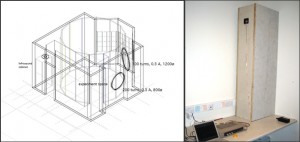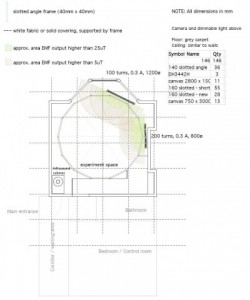
I’ve always been a proponent of the theory that electromagnetism can be responsible for ghosts. Or at least most of the reported sightings of them. People who live in areas with high EMF activity will tend to undergo poltergeist or paranormal activity. Such was the case with the Wyrick family haunting that was made famous by the Discovery channel when it aired as “A haunting in Georgia”.
I’m not saying that the Wyrick case was a real haunting or a hoax. What I’m saying is that the Wyricks lived underneath some major electric power/wire towers. The leading paranormal researcher did manage to get high EMF readings throughout the home, leading to the belief that long exposure to such forces can cause hallucinations and the feeling of being watched or followed.
This article by Wired.com is about a group of scientists that set out to build a “haunted room” by using high EMF and waves of infrasound.
Full source: Wired
By Brandon Keim
Fake blood, canned screams and plastic skeletons are fun, but if you want a real haunted house, turn to scientists.
To test whether it’s possible to artificially induce paranormal experiences — or, from a different perspective, to technologically summon a spirit — researchers at London’s Goldsmith College and architect Usman Haque designed a scientifically haunted room.
They were inspired by earlier studies in which test subjects reported contact with the phantasmic when exposed to electromagnetic fields and waves of infrasound.
This hasn’t just taken place in the laboratory. Odd EMF fields have been recorded at reputedly haunted castles. And geomagnetic flux caused by shifting tectonic plates reportedly produces surges in poltergeist sightings. Meanwhile, infrasound waves below the level of human hearing have been linked to visitation.
Of course, ghosts — which 40 percent of the American public claim to believe in — are only one possible explanation. Perhaps people feel something, and what they call “haunting” is their uniquely sensitive power of perception. Maybe they’re just suggestible.
So Christopher French, head of Goldsmith’s Anomalistic Psychology Research Unit and editor of the Skeptic magazine, built the haunted room: a white, wood-frame canvas tent 9 feet in diameter, located in the front room of a London row house. It was entirely featureless, but hidden speakers cast infrasound waves like those measured in supposedly-haunted Coventry Cathedral. Other speakers projected sound waves that produced an electromagnetic frequency used in laboratory stimulation of paranormal feeling.
Each field’s range was focused in a different part of the room, and some areas were field-free. If haunting indeed had a wavelength, then people would ostensibly report unusual experiences in the target areas.
Seventy-nine students, friends of Haque and other volunteers entered the room, which operated during the Fall of 2006. Their responses were published this May in Cortex — and respond they certainly did. After spending less than an hour in the room, nearly three-quarters reported having more than three unusual feelings. Just 6 percent felt nothing. Among the common sensations were dizziness, tingling, disembodiment, dream-remembrance and “a presence.” Several felt sexually aroused.
But there was a catch: The sensations had nothing to do with where they were standing in the room.
When French’s team crunched the numbers, the only statistically significant association appeared in subjects who scored highly on a test of psychological predisposition to the sort of transcendental feelings generally experienced by epileptics with unstable temporal lobes.
There are a few different ways of looking at these results, said French. “It might be that certain people are wired up in a particular way, and in the right environment, they actually are seeing something that’s objectively there, but others don’t have the ability to see,” he said.
But while that can’t be ruled out, he thinks there’s a simpler explanation: People tend to think about what they’re told to. Asked to track strange feelings, they started noticing them. And the participants’ response rates indeed followed what’s predicted by models of suggestible behavior.
“We did manage to build an artificially haunted room, but it wasn’t related to the environmental factors, but to suggestibility,” said French, who’d hoped for a firmer result. An EMF effect would have been exciting, and opened up new lines of investigation, he said.
Of course, French still acknowledged that out-of-lab paranormal experiences could be real, or that his experimental waveforms may have failed to replicate those found naturally. He hopes to repleat the study using “a very different, very anomalous pattern of EMF activity” he recently recorded in Muncaster Castle, said to be one of the most haunted castles in the United Kingdom.
As for whether he’d felt anything inside the haunted room, French admitted that he hadn’t spent much time there.
“I went in and out when we were setting it up, but I didn’t even make myself a pilot participant,” he said. “Maybe I should have.”





